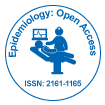Kinematic Causes and Exercise Rehabilitations of Patients with Round Shoulder, Thoracic Kyphosis and Forward Head Posture (FHP)
Received Date: Jul 25, 2016 / Accepted Date: Sep 12, 2016 / Published Date: Sep 19, 2016
Abstract
Purpose: To analyze the cause in kinematics and corresponding exercise rehabilitation of round shoulder, thoracic kyphosis and forward head posture. Methods: We recruited 26 patients with obvious symptoms of round shoulder, thoracickyphosis and forward head posture, with a difference of 4 degree or more in positive rake angle. Patients include 16 males with an average age of 24 ± 3.4 (Mean ± SD) and 10 females with an average age of 25 ± 3.7, with an overall duration of pathological symptoms of 3.4 ± 1.3 years. The sports prescription effectiveness was evaluated base on positive rake angle, neck vertebrae mobility and glenohumeral mobility. Results: The positive rake angles were decreased from 5.4 ± 2.6 degrees (pretreatment) to 2.2 ± 1.2 degrees (post-treatment). Cervical joint mobility range bending from front to back was improved from 56.8 ± 2.6 degrees (pre-treatment) to 76.6 ± 2.2 degrees (post-treatment), the range bending from left to right improved from 46.1 ± 3.7 degrees (pre-treatment) to 80.1 ± 3.4 degrees (post-treatment), and the range rotating from left to right improved from 80.5 ± 9.2 degrees (pre-treatment) to 122.8 ± 9.6 degrees(post-treatment). The glenohumeral mobility was improved from 144.7 ± 7.5 degrees (internal bending), 43.4 ± 4.7 degrees (external stretching), 77.3 ± 5.7 degrees (internal rotation), 69.8 ± 5.3 degrees (external rotation) to 172.3 ± 6.8 degrees (internal bending), 54.5 ± 4.1 degrees (external stretching), 83.2 ± 6.6 degrees (internal rotation), 80.4 ± 7.3 degrees (external rotation). Significant difference between pre-treatment and post-treatment were observed based on evaluation of all three factors (p<0.05). Conclusion: Abnormal postures, such as round shoulder, thoracic kyphosis and forward head posture, could be resulted from long-time operation of computers, which induced unbalanced kinematics of muscles around the neck, chest and back. Underload resistive exercises and stretching of chest and arms have significant improving effect for correcting round shoulder, thoracic kyphosis and forward head posture.
Keywords: Round shoulder; Thoracic kyphosis; Forward head posture (FHP); Unbalanced kinematics; Sports prescription
Citation: Chen X, Pin LV, Peng, Zhang Y, Ding K (2016) Kinematic Causes and Exercise Rehabilitations of Patients with Round Shoulder, Thoracic Kyphosis and Forward Head Posture (FHP). Epidemiology (Sunnyvale) 6:263. Doi: 10.4172/2161-1165.1000263
Copyright: © 2016 Chen X. This is an open-access article distributed under the terms of the Creative Commons Attribution License, which permits unrestricted use, distribution, and reproduction in any medium, provided the original author and source are credited.
Select your language of interest to view the total content in your interested language
Share This Article
Recommended Journals
Open Access Journals
Article Tools
Article Usage
- Total views: 21707
- [From(publication date): 10-2016 - Nov 14, 2025]
- Breakdown by view type
- HTML page views: 20265
- PDF downloads: 1442
